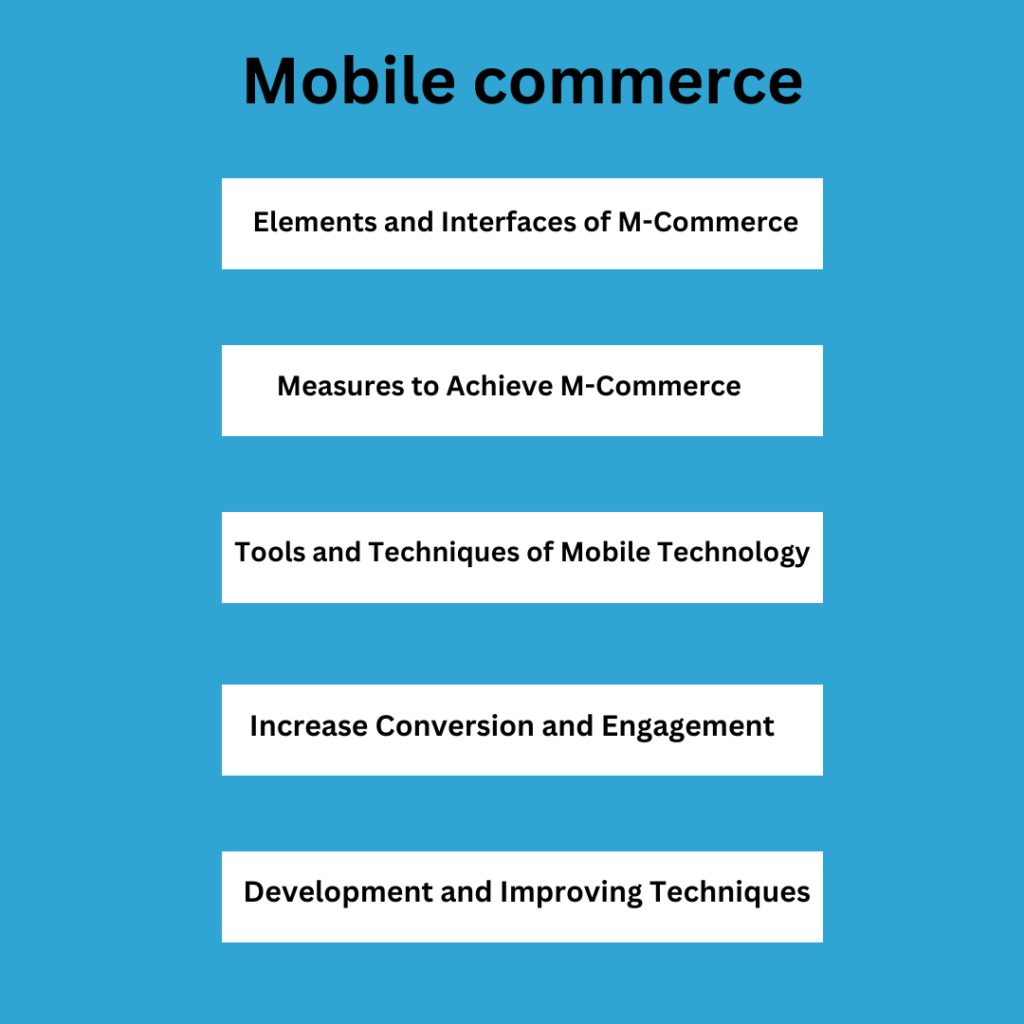Utilizing portable electronics, such as tablets and smartphones, for purchasing and selling is known as mobile commerce or M-Commerce. It’s an e-commerce subcategory that specializes in transactions via mobile platforms. Anywhere there is a wireless internet provider present, customers may transact via m-commerce. Customers may use it to purchase and sell goods, pay for services and bills, utilize digital wallets and online banking, and more.

Essential Elements and Interfaces of M-Commerce
Essential Elements and Interfaces in Mobile Commerce Explores the important elements and interfaces in this field. Key elements like user interfaces, payment methods, security protocols, and technology infrastructure that facilitate smooth transactions on mobile platforms are covered in this blog. Businesses and developers must comprehend these principles in order to design effective and user-friendly mobile commerce applications that guarantee customers have a great time navigating the mobile buying environment.
Mobile-Friendly Website or App
Consider mobile devices while designing to ensure the best possible viewing experience. For ease of use, make checkout procedures more efficient and navigation simpler. Make use of clear material and excellent images for mobile viewing. Make sure all platforms are thoroughly tested for compatibility and performance.
An attractive user interface
In order to influence user engagement and satisfaction, m-commerce requires an attractive user interface. It should put a focus on visual appeal, ease of use, and simplicity, with clear calls to action and a quick checkout procedure. Good quality photos, eye-catching color schemes, and responsive design improve usability on various platforms. Ultimately, increasing sales, gaining and keeping consumers, and establishing a positive brand image all depend on a well-designed user interface.
Safe Payment Gateway
For m-commerce, selecting a secure payment gateway is essential. Seek alternatives with a reputation for strong encryption, PCI compliance, and fraud prevention, such as Square, PayPal, and Stripe. Tokenization for increased security, two-factor authentication, and seamless integration are all provided by these gateways. Give preference to gateways that have a proven track record of protecting customer data and facilitating seamless transactions.
Personalization
In e-commerce, personalization refers to utilizing data analytics and artificial intelligence (AI) to modify users’ purchasing experiences according to their preferences, behavior, and demographics. Based on previous purchases or browsing history, it offers customized discounts, targeted offers, and personalized product recommendations. This increases customer loyalty, satisfaction, conversion rates, and engagement in the cutthroat m-commerce sector.
Strategies for mobile marketing
Effective marketing is essential for engaging smartphone and tablet users in today’s mobile-driven world. Companies should prioritize creating mobile-friendly apps and websites to guarantee seamless user experiences. Personalized communication is made possible by targeted SMS and push notifications, and precise targeting is made possible by location-based marketing. Conversion rates are increased, and brand visibility is increased by utilizing mobile-optimized social media and spending money on mobile advertisements. In the digital age, these tactics assist companies in engaging with their mobile clientele and fostering expansion.
Tools and Techniques of Mobile Technology
The field of mobile technology includes a broad range of instruments and methods designed to improve the usability, accessibility, and functionality of mobile devices. These include mobile-specific programming languages like Swift and Kotlin, operating systems like iOS and Android, and development frameworks for creating apps like React Native and Flutter. Mobile technology also makes use of methods like mobile security protocols to protect sensitive data, mobile analytics to track user behavior, and responsive design to create layouts that are flexible across devices. As mobile technology develops further, it offers creative answers to the needs of a world that is becoming more and more mobile-driven.
Strategies to Increase Engagement and Conversion
Provide a mobile-friendly checkout experience to engage your customers.
Although many retailers allow their mobile customers to check out, these checkout processes often require a lot of input from the customer and are only sometimes optimized for a mobile device. Up to 85.6% of consumers give up on a mobile eCommerce transaction because it takes too long on average! The secret is knowing how to expedite and simplify the mobile checkout process for customers.
Make your website mobile-friendly
Make sure your website is optimized for mobile, including tablets and smartphones.
Consumers are more inclined to become converts and buy things. From your store, if you make it simple for them to finish an online transaction. Customers should be able to easily use your website on their mobile devices, thanks to optimization. They will be able to easily peruse all of your offerings with a touchscreen interface and make one-touch purchases thanks to this.
Show product recommendations on the page.
Additionally, you can use your website to show product recommendations right on the page. Because it only takes one more step for the customer who has already expressed interest in what you’re selling, this is a great method to increase conversions!
The following techniques should be taken into consideration if you wish to display product recommendations on your website:
Each page should have links at the top and bottom. These ought to have backlinks pointing to particular items you want buyers to purchase. Put a widget that suggests related products on your homepage; these work well for e-commerce sites.
Make it easier for visitors to use your mobile website.
The idea that mobile websites are hard to use is a common one, but it couldn’t be further from reality! You can ensure users can easily navigate your website by including links at key locations on your important pages.
Tracking Development and Improving Techniques
Evolution of Mobile Commerce Platforms
Improving the User Experience (UX) in Mobile Commerce
Insights driven by data and personalization
Security and Trust in Mobile Transactions
Conclusion
In summary, utilizing mobile commerce is critical to maintaining your competitiveness in the modern digital market. Businesses can fully realize the potential of mobile commerce by implementing tactics that work, such as optimizing for mobile UX, utilizing data-driven insights, and placing a high priority on security. To succeed in mobile commerce, businesses must constantly innovate and adjust to their clients’ shifting demands. By implementing the right plan, businesses may benefit from the opportunities presented by mobile commerce and encourage long-term growth.
FAQ
Which three categories of mobile commerce exist?
The three primary categories of m-commerce mobile payments, mobile banking, and mobile shopping that are experiencing the fastest development are In-app purchases (like making clothes purchases using a retail app) and mobile money transfers.
What is a strategy for mobile commerce?
Buying and selling products and services using wireless handheld devices, including smartphones and tablets, is known as m-commerce or mobile commerce. M-commerce is a type of e-commerce that lets customers shop online without requiring a desktop computer.
How broad-reaching is m-commerce?
Businesses can compete and develop in the “Mobile Commerce Market” by offering solutions that respond to a diverse variety of client needs. It is essential to the economy as a whole and significantly promotes growth and development.
What advantages does mobile commerce offer?
Customers can complete purchases more quickly using m-commerce because most mobile applications are often speedier than traditional websites. In the world of e-commerce, time is money; therefore, offering clients the option to make purchases faster than usual can be quite profitable.
Who was the first person in charge of mobile shopping?
Kevin Duffey coined the word “m-commerce” in 1997. Duffey initially discussed mobile commerce at the Global Mobile Commerce Forum held in London.

